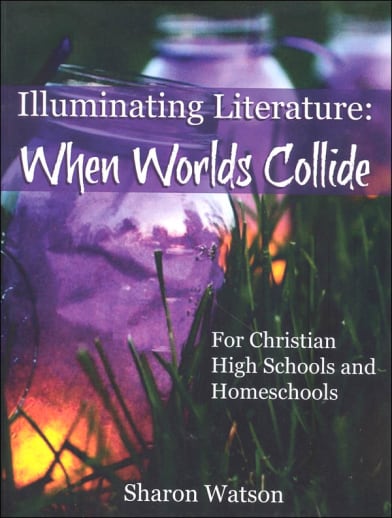The Student Text is fairly self-directed, written as a conversation to the student. Students are guided, step by step through learning about and responding to their reading. Each chapter covers one book in 6-9 lessons. The lessons combine instruction and workbook into one format so that students respond to questions as students read through the text. As they complete their study of the literature, students must evaluate the conflict "colliding worlds" (man vs. man; man vs. ideas, etc.) involved, complete the quizzes and survey, take a vocabulary "quizzola," and complete the final, culminating activity. An "If You Liked This Book" section includes a list of additional readings. 8.5" x 11" 285 pp, sc.
Illuminating Literature: When Worlds Collide Student Text
SKU
001057
ISBN
9781484035986
Grade 9-12
Traditional
Christian/Religious
Low Teacher Involvement
Visual
Other Materials Required
These icons are designed to help you quickly understand and learn important information about our products.
Teaching Method
Traditional
Teacher-centered curriculum commonly used in classrooms that may include a text, teacher manual, tests, etc.
Charlotte Mason
A methodology based on the work of a 19th century educator who maintained that children learn best from literature (Living Books), not textbooks.
Classical
A methodology based on the Latin Trivium (three stages of learning), including the grammar stage (memorization and facts), logic stage (critical thinking), and rhetoric stage (developing/defending ideas).
Unit Study
A thematic or topical approach centered around one topic that integrates multiple subject areas.
Montessori (Discovery)
A methodology based on the work of a 20th century educator that emphasizes student and sensory-driven discovery learning and real-life applications.
Other
Other methodologies
Religious Content
Secular
Contains content contrary to common Christian beliefs (i.e. evolution).
Neutral
Avoids religious or theoretical topics or presents multiple viewpoints without preference.
Christian/Religious
Faith-based or including instructional religious content.
Learning Modality
Auditory
Learns through listening, talking out loud or reading out loud.
Visual
Learns through seeing, prefers written instructions and visual materials.
Kinesthetic/Tactile (Hands-On)
Learns through moving, doing and touching.
Multi-Sensory
Curriculum that employ a variety of activities/components.
Presentation
Sequential
Curriculum progresses through well-defined learning objectives. Emphasizes mastery before moving to the next topic.
Spiral
Topics and concepts are repeated from level to level, adding more depth at each pass and connecting with review.
Conceptual/Topical
Focus is on the “why,” often with a unifying concept as well as specific skills; coverage may be broader.
Teacher Involvement
Low Teacher Involvement
Student-led materials; parent acts as a facilitator.
Medium Teacher Involvement
A mix of teacher-led time and independent student work.
High Teacher Involvement
Teacher-led lessons; may utilize discussions, hands-on activities and working together.
Additional Materials Required
No other materials needed
Everything you need is included.
Other Materials Required
There are additional required resources that are a separate purchase.
Other Materials Optional
There are additional resources mentioned or recommended but are not absolutely necessary.
Consumable
Consumable
Designed to be written in; not reusable.
Non-Consumable
Not designed to be written in; reusable.
Our Price
$39.49 $39.49 $36.45
Rainbow Savings: $3.04
Description
Publisher's Description of Illuminating Literature: When Worlds Collide Student Text
Your teens will appreciate the unstuffy way Sharon Watson teaches literature. They'll read some great novels, encounter the hero's journey, learn literary terms and elements, and gain an appreciation for fine literature.
More important, eager and reluctant readers will become more discerning as they learn the secret craft of the writer.
Prepare your teens for college literature courses and for the rest of their reading life.
- Written for Christian high schools, homeschools, and co-ops.
- Two-semester course earning one credit for language arts or English. 70 lessons.
- Student-directed, with clear lessons and reading schedules.
Category Description for Illuminating Literature: When Worlds Collide
When Worlds Collide provides 70 lessons that studies 8 classic
pieces: Pudd’nhead Wilson; The War of the Worlds; Friendly Persuasion; Peter
Pan; Warriors Don’t Cry; Tale of Two Cities; Fahrenheit 451 and Screwtape
Letters. Successful completion of this two-semester, college-preparatory
course earns one credit for Language Arts or English.
Details
| Product Format: | Paperback |
|---|---|
| Grades: | 9-12 |
| Brand: | Writing with Sharon Watson |
| Author: | Sharon Watson |
| ISBN: | 9781484035986 |
| Length in Inches: | 11.0625 |
| Width in Inches: | 8.5625 |
| Height in Inches: | 0.6875 |
| Weight in Pounds: | 1.75 |
Videos
Reviews

